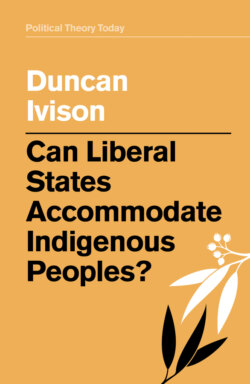Can Liberal States Accommodate Indigenous Peoples?

Реклама. ООО «ЛитРес», ИНН: 7719571260.
Оглавление
Duncan Ivison. Can Liberal States Accommodate Indigenous Peoples?
Contents
Guide
Pages
Series title. Political Theory Today series
Can Liberal States Accommodate Indigenous Peoples?
Copyright page
Acknowledgements
Preface: Uluru
Notes
1 The Challenge. Introduction
Outlining the Challenge
What is Liberalism?
Liberalism and Structural Injustice
The Intervention
Conclusion
Notes
2 Multiculturalism. Introduction
Defining and Defending Multiculturalism
Liberal Multiculturalism and Its Critics
Justifying Liberal Multiculturalism
Multiculturalism and Indigenous Peoples
Notes
3 Rights. Introduction
The Nature of Rights
What are Aboriginal Rights?
Objections
Conclusion
Notes
4 Legitimacy and Justice. Introduction
Mutual Justification
Recognition
Power and Justification
A Constellation of Normative Orders
Reconstructing Liberal Legitimacy
Hope from Below … and Above …
Notes
References
Cases
POLITY END USER LICENSE AGREEMENT
Отрывок из книги
Duncan Ivison
I owe a debt of gratitude of a different order to Diana, Hamish and Isobel, for their continuous love and support.
.....
Three major recommendations emerged from the Convention and the ‘Statement from the Heart’. The first was that a referendum should be held to enshrine a First Nations ‘Voice’ to Parliament. This would be a representative body of First Nations traditional owners to advise Parliament on policy affecting Aboriginal and Torres Strait Islander people. It would be a first step to addressing the ‘torment of our powerlessness’. Further discussions would be needed to define exactly what kind of representative body it would be, but the constitutional guarantee of its existence was critical. Previous advisory bodies have been created but then dismissed at the whim of governments. At the same time, the Council made clear it was not intended to have a veto over legislation. It would be a political mechanism for enhancing dialogue and improving the lives of Indigenous peoples.
The second and third recommendations were extra-constitutional in nature. The Council recommended that a ‘Declaration of Recognition’ be enacted by legislation passed by all Australian parliaments, bringing together the three parts of the ‘Australian story’: ‘our ancient First Peoples’ heritage and culture, our British institutions, and our multicultural unity’. And finally, it recommends that a ‘Makarrata Commission’ be established; the ‘culmination of our agenda’, as the Statement puts it. Makarrata is a Yolngu word taken from a dispute resolution ceremony from the Gumatj people in the northeast corner of Australia. It refers to two parties coming together, after a struggle, to heal the wounds of the past and to work towards establishing just relations for the future. There are two crucial elements to this concept that the Council highlights. The first is the need to establish an agreement-making process between First Nations and federal and state governments – a treaty process. The second is the need for truth-telling. A Makarrata Commission would provide a mechanism and public space for ‘truth telling about our history’. It’s important to note how closely the call for truth-telling is linked to the proposed treaty process: it’s not only about reckoning with the past, but also informing and shaping the future.2 The renowned Australian anthropologist W. H. Stanner once said that the persistent absence of Aboriginal peoples from Australia’s history constituted a ‘cult of forgetfulness’.3 The Uluru Statement demands that we abandon that cult once and for all.
.....